This is our Everest Base Camp Trek Part 3, the conclusion of our unforgettable adventure!
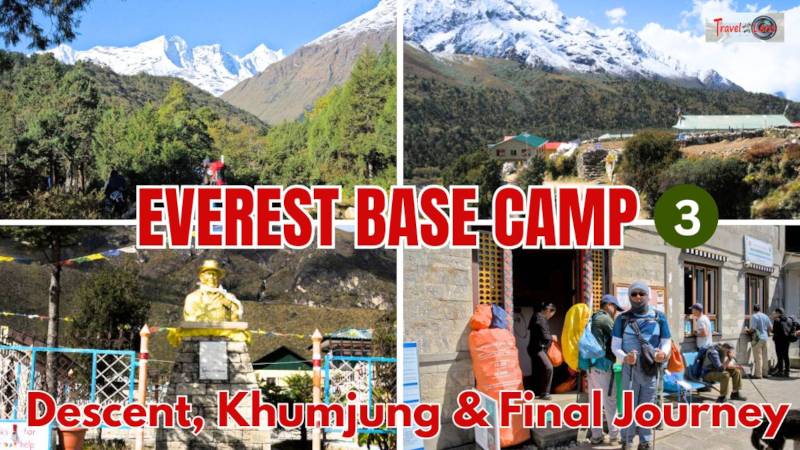
Recap of the previous two parts
Just a quick recap: we began our journey from Lukla, and upon reaching Dingboche (4,410m), our team decided to split. My brother Ka Kui and my friend Bernard continued their ascent toward Everest Base Camp, while I decided to descend slowly through Pheriche, Khumjung, and Khunde due to AMS.
In this part of the story, I’ll take you along my descent to explore Khumjung Monastery, the Sir Edmund Hillary Visitor Center, and Kunde Hospital, the first hospital Sir Edmund Hillary built in the Khumbu region.
After Ka Kui and Bernard successfully reached Everest Base Camp, they made their descent and reunited with me at Namche Bazaar. From there, we trekked together back to Lukla, marking the end of our incredible journey.
EBC Day 10 – Deboche to Khumjung (3,800 m)
Today, I descended further to just below 3,800 m at Khumjung. While this isn’t part of the main EBC route from Namche, the section between Namche Bazaar and Deboche is shared, so it still feels familiar.
From Deboche to Khumjung
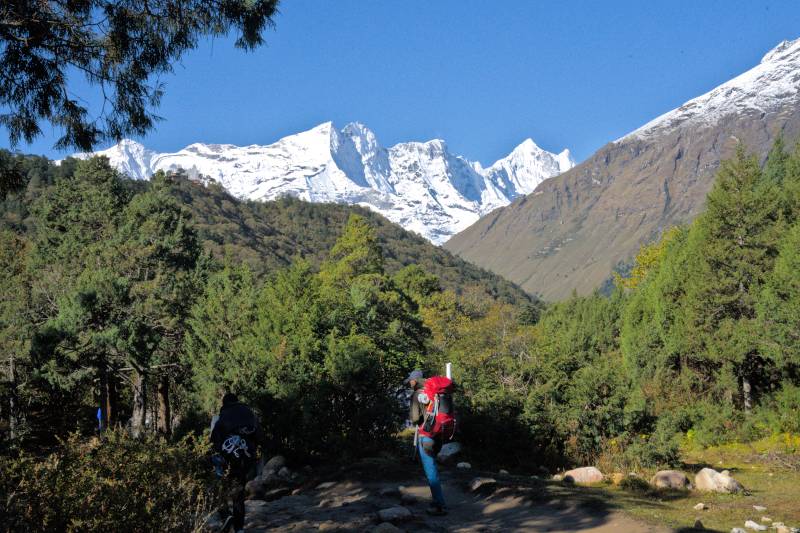
After breakfast (chapati and tea), I started my hike and unexpectedly met a Canadian guy, Nicholas, who has lived in Kuala Lumpur for six years!
We had plenty to chat about: KL food, favorite hangouts, and Malaysian life in general. Interestingly, this trip has connected me with quite a few people who’ve lived or worked in Malaysia, from hotel staff who once worked in Penang, to my porter’s sister who’s currently in Kuala Lumpur!
Before parting ways at Tyangboche Monastery, we took a some photos together as a nice keepsake.

The trek today was mostly downhill and easy-going. We stopped for lunch at Green Valley Lodge and Restaurant in Tashinga (Lawishasa). Up to this point, there were still quite a lot of trekkers, but once we turned toward Khumjung, which is off the main EBC trail, the path became peaceful and quiet. I loved it! Sometimes, stepping off the beaten path reveals a side of the Himalayas most trekkers never see.
Khumjung is a Beautiful Village
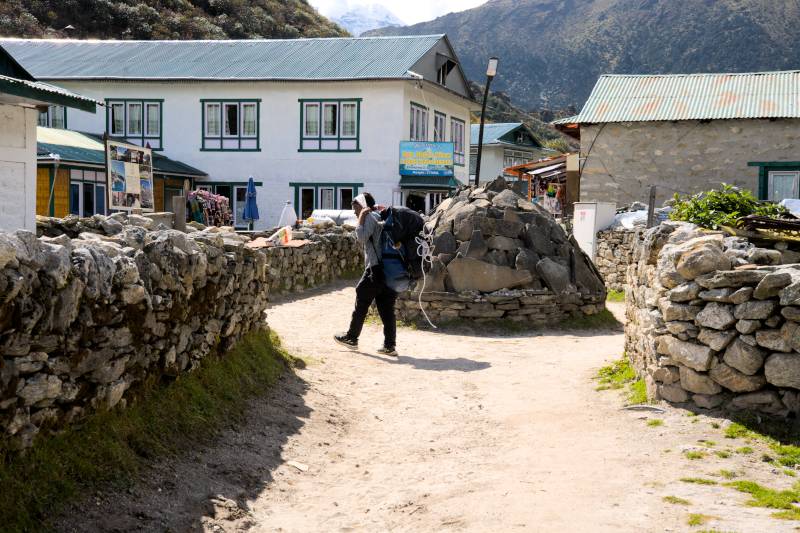
Khumjung is a charming and picturesque Sherpa village. The main street is lined with shops, restaurants, and lodges, but once you wander into the smaller lanes, it becomes a lovely maze of stone houses where locals live.

Every house here has a green roof, forming a beautiful jigsaw of emerald tiles across the valley. At the Sir Edmund Hillary Visitor Center, a local lady explained that they painted the roofs green because during winter, all vegetation disappears under snow, so the roofs bring a sense of life and greenery to the village.

Hillary School & Sir Edmund Hillary Visitor Center
Just a 5-minute walk from my hotel (Hidden Valley) is the Hillary School, built in 1961 by Sir Edmund Hillary, the first man to summit Everest in 1953 with Tenzing Norgay.

This was the first school he established in the Solu-Khumbu region. The Visitor Center, located within the school, was originally made by combining the first two classrooms.
Since it’s school holidays, there were no classes. I visited the school and saw a gold statue of Sir Edmund Hillary near the entrance.

The Visitor Center (entrance fee NPR 300, free for locals) displays the historical photos of Hillary’s work in the region, the old student drawings and homework, a large painting of Khumjung village, and exhibits about Sherpa life, education, and healthcare development
I also watched a 13-minute English documentary tracing Hillary’s journey from summiting Everest to improving education and healthcare in the region, including his role in building the airstrip at Lukla, now known as the Tenzing-Hillary Airport.

Khumjung Monastery
The Khumjung Monastery stands out beautifully, perched high above the village, painted in red, surrounded by houses with green rooftops.

The entrance fee for foreigners is NPR 300 (free for locals). I need to switch to the slippers provided at the door to keep the monastery clean.
It’s a three-story building, with the main prayer hall on the ground floor. The walls are decorated with colorful thangkas, and at the center back are statues of Buddha and various deities.

But the highlight, and what brings the monastery to fame, is the Yeti scalp, displayed in a locked glass case right at the center of the hall. It looks like a brownish dome of fur, about 6 inches across. Below it is a photo of the Yeti scalp, which (to me) looks more like a gorilla! There’s also a donation box on top of the glass case.

The first floor display exhibits about Sir Edmund Hillary and another prayer room.
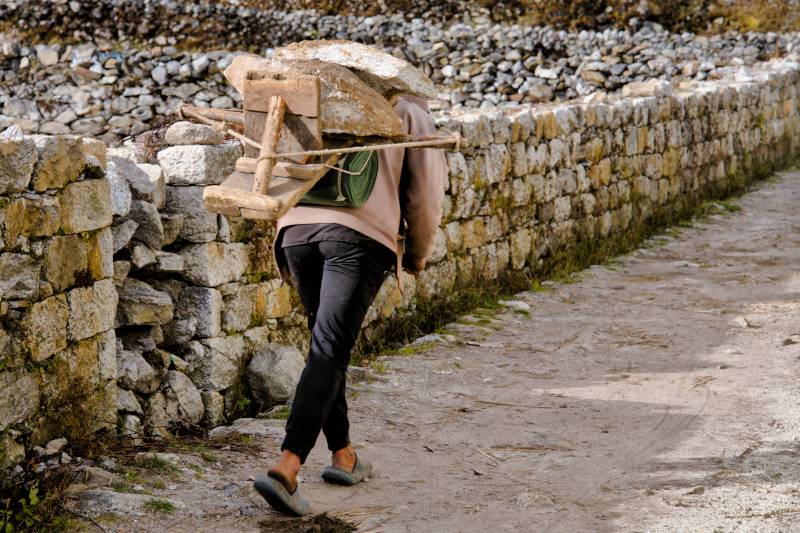
I’ll be heading back to Namche Bazaar tomorrow to relax and wait for them to reunite the following day. Can’t wait!
EBC Day 11 – Return to Namche Bazaar via Khunde
Khunde Visit
Earlier in the morning today, I made a short diversion to Khunde, the sister village of Khumjung, just about a 20-minute walk from Khumjung.

Khunde is smaller than Khumjung but equally beautiful, with many charming brick houses. There’s also a monastery here, but since I visited the one in Khumjung yesterday, I decided to skip it this time.
The Khumjung–Khunde area is where Sir Edmund Hillary made remarkable contributions to the Sherpa community. I came specifically to visit the Khunde Hospital, which was founded by him.

We arrived before 8 a.m., and it was very quiet as the hospital opens at 9. Since the door wasn’t locked, we stepped inside and took a few photos and short videos. While visiting a hospital isn’t a typical trekking stop, I wanted to see firsthand the legacy of Hillary’s compassion and dedication to the Sherpa people.

The Vibrant Namche Bazaar Walkaround
After visiting Khunde, I slowly hiked down to Namche Bazaar, an easy downhill trail. By around 10 a.m., I reached the town and immediately felt like I had returned to “civilization.”
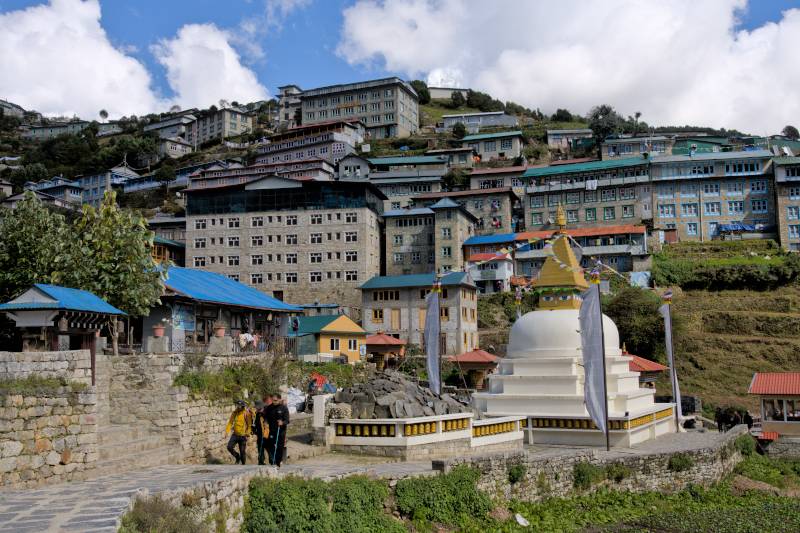
Namche is a bustling mountain hub, full of trekkers, porters, and locals. It’s amazing how this lively town was built without any road access for vehicles. Everything I see here was carried up by human or animal strength. Truly incredible.
Since I’ll be staying in Namche Bazaar waiting for my teammates to return from EBC, I have had plenty of time to wander around, enjoy the mountain air, and pick up a few souvenirs.
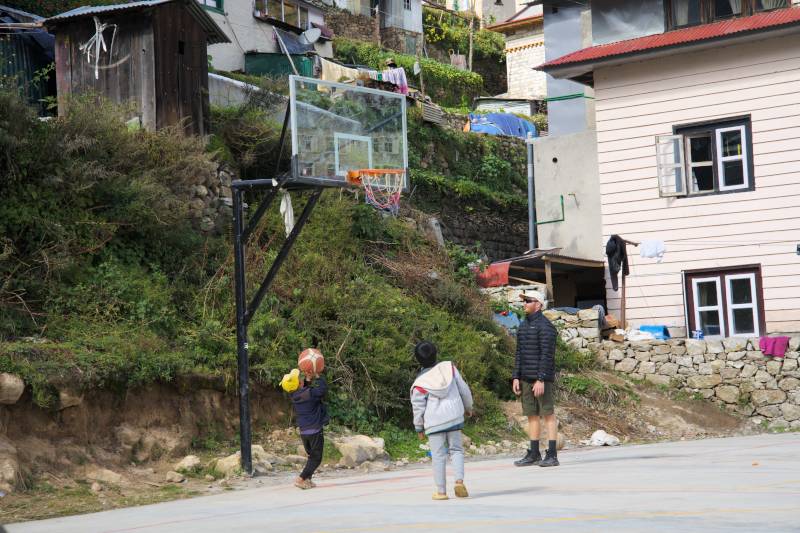
As soon as I enter Namche through the gate adorned with colorful thangkas, it feels like a different world from the wild Himalayas beyond. On the right of the stone-paved steps are five large water-powered prayer wheels, spinning endlessly. On the left sits a cozy café, where I enjoyed a café latte and apple pie. Not far from Stupa Cafe stands a statue of Pemba Doma Sherpa, the first Nepali woman to successfully climb Mount Everest.

Several cows rested freely on the street, unbothered by the lively flow of trekkers and porters passing by. Further up is the Namche Bazaar Stupa, followed by the main street lined with cafés & restaurants, hotels & lodges, massage parlors & spas, banks, ATMs & money changers, hiking gear shops & souvenir stalls, and even hair salons and digital shops.
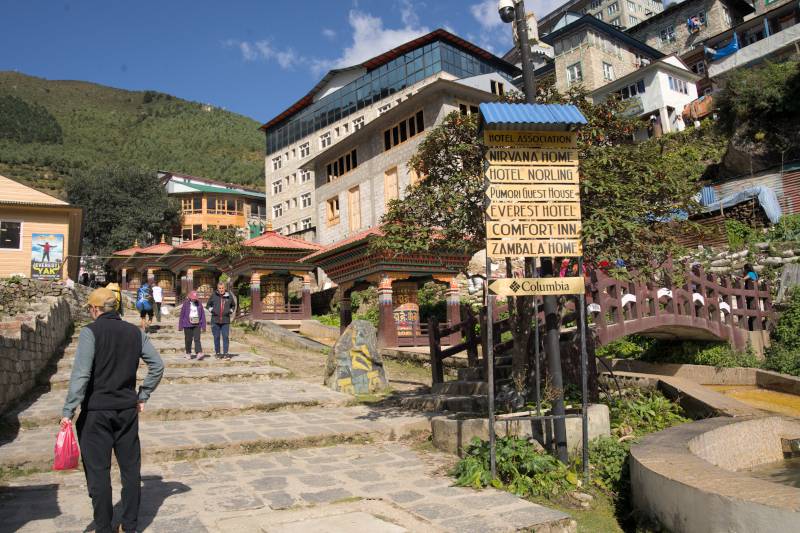
Enjoying my coffee and apple pie at Stupa Café, right near the town entrance, I couldn’t help but appreciate the contrast: the bustling energy of Namche versus the peaceful simplicity of the higher mountain villages.
Teammates’ Update
Got an update from Ka Kui and Bernard that they’ve started descending from Pheriche to Phortse.
From Bernard’s photo, it looks like a bright sunny day, still covered in ice but slowly improving. Ka Kui mentioned that the trail conditions are much better now, and crampons are no longer needed.
Surprise! Surprise! What a shock when someone tried to open my locked door before dinner. It was my brother, Ka Kui! Apparently, they didn’t stop at Phortse as planned but pushed through with a 10-hour hike (with only a short lunch break!) all the way down to Namche Bazaar from Pheriche!
They had secretly planned to surprise me, and they did! The team reunited one day earlier than expected.
EBC Day 12 & 13 – From Mountain to Kathmandu
These two days mark the conclusion of our Everest Base Camp adventure.
As we retraced the same trail we took on our way up, the scenery and villages felt familiar yet somehow different, as if viewed through new eyes after all we’ve experienced.
Goodbye, Namche Bazaar
We started late today as there was no rush for the descent to Phakding. Along the way, something meaningful caught our attention: the Carry Me Back program we first learned about at Sagarmatha Next.

Each of us picked up 2 kg of waste at the police checkpoint to carry back to the collection center in Lukla. It added a bit of weight to our packs, but knowing it helped keep this sacred trail clean made it absolutely worthwhile.

We spent the night in Phakding, a much lower altitude at 2,610 m, and felt almost like being back near sea level in Kuala Lumpur. The air was thick, our breathing normal, and for the first time in many days, everything felt easy and restful.
Back to Lukla – Gateway to Sagarmatha National Park
The next morning, we took it slow, hiking leisurely back to Lukla.
Although it was the same trail we had walked just a week ago, going downhill made everything look completely different, even foreign. Only when we passed the small restaurant where we’d had lunch earlier in the trip did the memories start to resurface.

At the final checkpoint of Sagarmatha National Park, we proudly dropped off the 2 kg of waste we’d carried from Namche Bazaar. In return, each of us received a small plastic coin, a simple but meaningful token of appreciation.
Carrying just 2 kg of rubbish may seem insignificant, but when multiplied by hundreds of trekkers, it becomes a powerful movement. If everyone leaves nothing but footprints, we can make a real difference in preserving this fragile Himalayan environment.

A Taste of Comfort in Lukla
Upon arrival in Lukla, we checked into our hotel and enjoyed lunch at the restaurant. The menu was much more extensive than the standard offerings we’d used to in the mountain villages.
My teammates opted for chicken chop and burgers, while I couldn’t resist one last serving of simple fried rice and masala tea —the comforting “mountain flavors” I’d come to love.
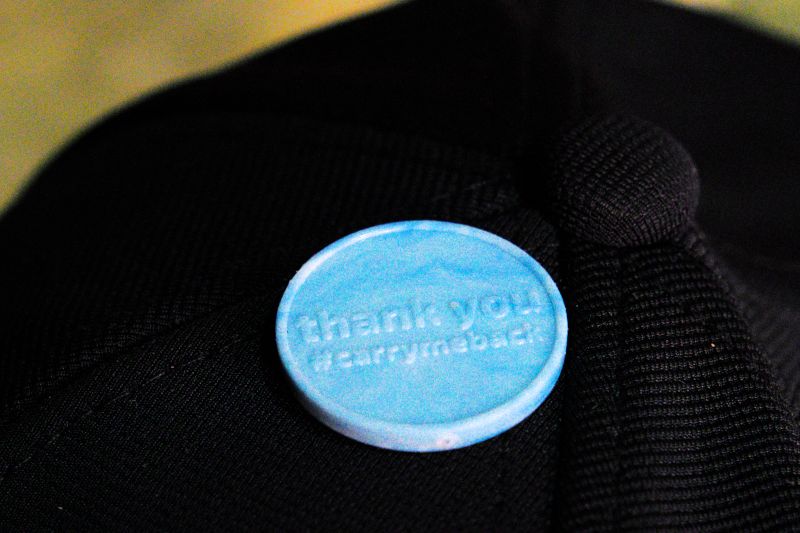
Adventurers Turned Tourists
After lunch, we all turned from rugged hikers into relaxed tourists, strolling along Lukla’s single main street, lined with cafés, hotels, and souvenir shops.
We picked up embroidered Everest Base Camp T-shirts, fridge magnets, and caps as mementos. I also found a beautiful singing bowl, whose calming sound seems to carry the serenity of the mountain back home.
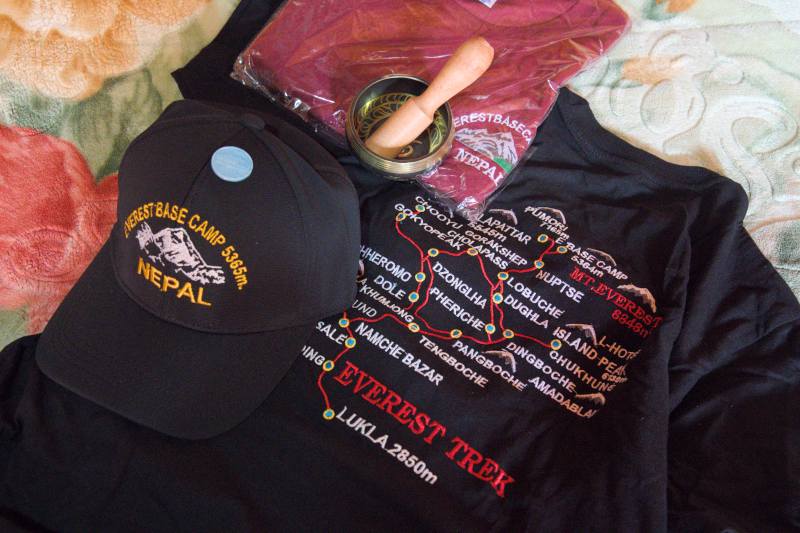
EBC Day 14 – The Final Chapter
Final thought
Our small team made it to Everest Base Camp, a relatively simple task for the locals and our porters, but a significant challenge for us in terms of physical endurance and adapting to the thin air at high altitude.
I chose not to push beyond my limit after being hit by AMS (Acute Mountain Sickness). It wasn’t an easy decision, but exploring Khumjung and Khunde instead truly enriched my trekking experience. When I shifted my mindset from individual achievement to team success, I realized it was a win-win decision and a happy ending for all of us.

With no sore muscles, knee pain, or fatigue after each day’s trek, I’m convinced that my only real obstacle was AMS. The mountain will always be there, and when one day the mountain is calling me again, I’ll return with a more flexible schedule to allow extra days for acclimatization and give it another attempt, or a different destination.

The most valuable lesson I learned from this journey is the importance of rational decision-making over personal desire. My disappointment at not reaching EBC myself is real, but it has also reminded me that each of us has our own strengths and weaknesses. The key is to embrace them, to build on our strengths while improving what we’re not yet good at.
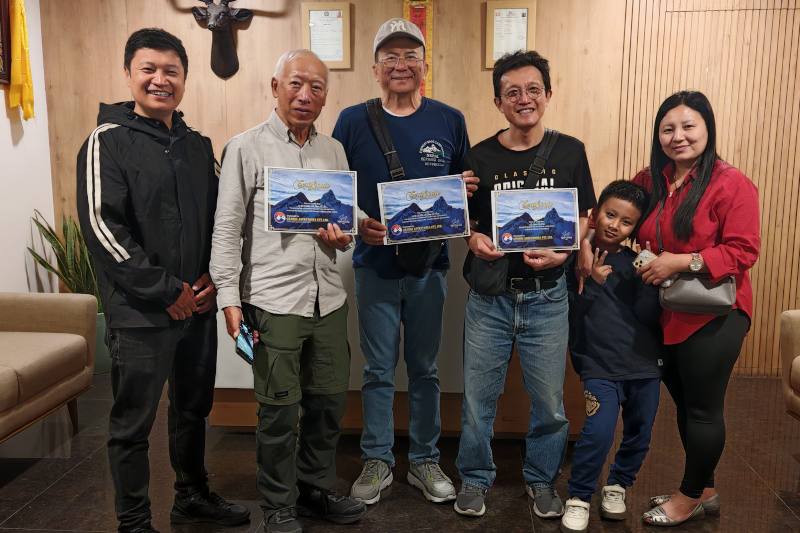
Leaving the mountain
Back in Kathmandu, the first round of shampoo barely produced any lather, the price of not showering and washing my hair for 14 days in the mountains! The second round finally brought those glorious bubbles, transforming me from a rugged hiker back into a city dweller. A clean shave and a touch of moisturizer made it almost unbelievable that I had just spent days in muddy boots, wet socks, and using toilets without running water.

Goodbye, Everest Base Camp Trek. Thank you for the lessons, the memories, and the unforgettable experiences.
🎞️ Watch our video: Everest Base Camp Trek Part 3
Please watch our Everest Base Camp Trek Part 3 by clicking 👇👇 on the image below.
This marks the end of our Everest Base Camp Trek Part 3. If you haven’t read Part 1 and Part 2 yet, here are the links: Part 1 | Part 2.

